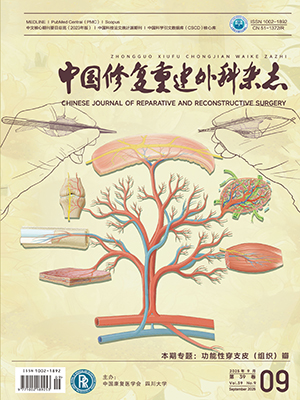Objective To study the blood supply of the distally pediceled composite vascular net flap of forearm and its clinical effect. Methods From February 2000 to December 2003, the distally pediceled composite vascular net flap of forearm was used to repair a series of 26 skin defects with bone or tendon exposure on the hand and wrist.Of 26 patients, there were 17 males and 9 females at ages of 18 to 56 years; 16 received emergency operation and 10 received selective operation. The flap sizes ranged for 10 cm ×5 cm to 18 cm×7 cm. Results Allof the flaps survived. At followup of 3 to 8 months, there was no flap loss, even partial and the outcome was satisfactory in all patients.Twopoint discrimination was 6 to 10 mm. Conclusion Plexus around the cutaneous nerves and the superficial vein are connected with the superficial subdermal plexus and the deep facial plexus by perforators from the underling main arteries, forming a threedimensional vascular network and in a sort of longitudinal axiality, which is the anatomic base of blood supply for the flaps. Blood supply to the flap is provided by the perforators arising from the deeply situated radial or ulnar arteries in the distal pedical. The advantage of this flap is its constant and reliable blood supply without sacrifice of the main artery. The elevation of the flapis simple and rapid, and the flap has a higher survival rate.
Citation: ZHAO Min,TIAN Dehu,ZHANG Yingze,et al.. REPAIR OF SKIN DEFECT ON WRIST AND HAND WITH DISTALLY PEDICELED COMPOSITE VASCULAR NET FLAP OF FOREARM. Chinese Journal of Reparative and Reconstructive Surgery, 2005, 19(12): 1001-1002. doi: Copy
Copyright © the editorial department of Chinese Journal of Reparative and Reconstructive Surgery of West China Medical Publisher. All rights reserved




